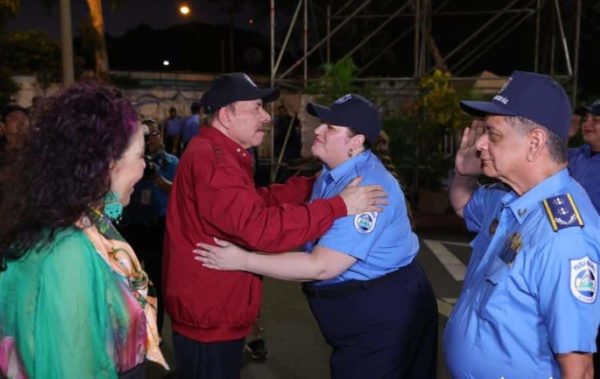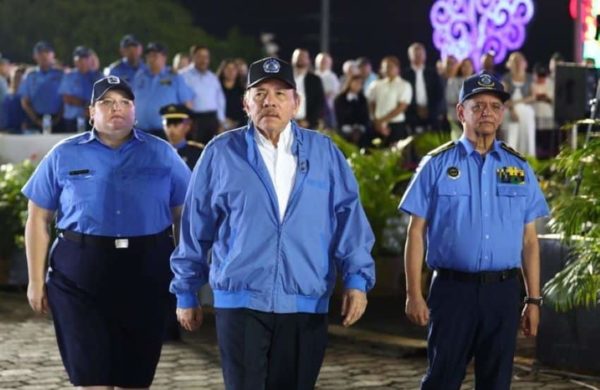Nicaragua’s Police Chief Denies Repression in the Country
while falsely boasting of “security”

The Nicaraguan dictator proclaims Nicaragua “the safest country in Central America,” ignoring his government’s repression and the manipulation of data.
HAVANA TIMES – The indicators cited by Nicaragua’s Head of Police Francisco Diaz to support his proclamation of Nicaragua as “the safest country in Central America,” don’t reflect the security realities of the country’s citizens. That’s the consensus of several analysts on the topic of security who spoke with Confidencial.
“Our country is the safest in Central America and one of the safest in Latin America,” declared Diaz during an official activity marking 45 years since the founding of Nicaragua’s National Police force. Immediately afterwards he boasted that Nicaragua “maintains a homicide rate of 6 murders for every 100,000 inhabitants.”
Salvadoran president Nayib Bukele has used similar claims to assert that the homicide rate in his country has fallen to 2.4 for every 100,000 residents.
“Calling Nicaragua or El Salvador the safest countries in the region doesn’t fit the reality. You can’t rest your case on only one indicator like the homicide rate, because there’s data showing that the rate of robberies and sexual violence have increased in nearly all the countries,” explained an expert on citizen security, who asked to remain anonymous.
In the Central American region, the official homicide rates have shown a tendency to decline over the past few years, especially in El Salvador, the expert points out. The exception is Costa Rica, which has shown an increase due to the growing penetration of drugtrafficking and organized crime.
According to data on the 2023 homicide rate from the non-profit think tank InSight Crime, which focus on organized crime in Latin America and the Caribbean, the Central American country with the highest murder rate per 100,000 inhabitants is Honduras with 31.1, followed by Belice with 21.5; Costa Rica with 17.2; Guatemala with 16.7; Panama with 11.5; Nicaragua with 6.2; and El Salvador with 2.4.
In his speech, Francico Diaz added: “only 2.6% of the crimes committed in the country are dangerous crimes – 97.4% of the complaints we receive are for minor crimes.”
Ortega’s in-law also stressed that Nicaragua continues being a reference point in Latin America for its high levels of security, and that there are neither Maras, gangs, nor cartels; while narcotraffickers have neither cells, bases, nor clandestine landing strips in the country. He added that from September 2023 to September 2024, the Nicaraguan police intercepted 1.7 tons of cocaine and 3.1 tons of marijuana.

Nicaraguan statistics are not credible
Another analyst consulted by Confidencial added that the statistics published by the dictatorship of Daniel Ortega and Rosario Murillo “aren’t reliable,” since “there’s no way of verifying them.”
“Although assassinations themselves can’t be hidden, because there’s a victim’s body present, the official data can hide them. What’s in doubt here is the official statistic, which in the case of Nicaragua can’t be believed due to the type of government policies that exist,” they asserted.
Similarly, the expert questioned the data “given the type of institution the Police have become – a repressive institution that has lost all legitimacy and trust.”
Nicaragua’s National Police have become the repressive arm of the Ortega-Murillo dictatorship and this repression has increased significantly since the September 2019 imposition of a de facto police state in the country.
This institution has assumed the job of persecuting and jailing citizens the regime sees as a threat, including political opponents, business leaders, activists and even high-level public officials who have fallen out of favor. In the same way, they squash any free expression or even religious expression.
Murders of indigenous people not included in the data
“A clear example of the existing difference between the official and the independent statistics is the discrepancy regarding those murdered during the 2018 crisis,” the analyst noted.
The analyst added: “the murders of the indigenous peoples as a result of the armed violence of invading colonists are counted in the statistics as general homicides, even though in most cases they’re homicides marked by planning and advantage as characteristic elements.”
The other expert repeated: “when contrasted with other types of crime and violence, the affirmation that the country is the safest in Central America is very relative.”
Both specialists agreed: “there’s no specific method to measure the security of a country. Some important aspects to take into consideration are: the official data, the index of victimization and the citizens’ perceived security.”






Bukele has also hidden and manipulated crime statistics. Upon coming into office, he changed the way homicides are count to leave out bodies found in clandestine graves as well those killed by the police. Narrowing the definition of homicide caused the rate to drop substantially. At the same time, the number of disappeared people went up. His administration has pressured relatives of disappeared persons to not even post about their missing loved ones on social media. The drop of the homicides reported during the state of exception is not reliable because Bukele has decreed that this information is a state secret. Police data obtained by journalists has demonstrated that the police’s own records show a higher homicide rate than that put out by the government. The official numbers do not include those who died in prison, often as the result of violence and torture. Salvadoran and international human rights organizations have found that some of the arrests under the state of exception have amounted to enforced disappearances because the relatives are unable to find any information about the whereabouts or health status of their jailed loved ones. There have been reports of prisoners being buried in mass graves inside of the prisons without any report of their deaths to their families.